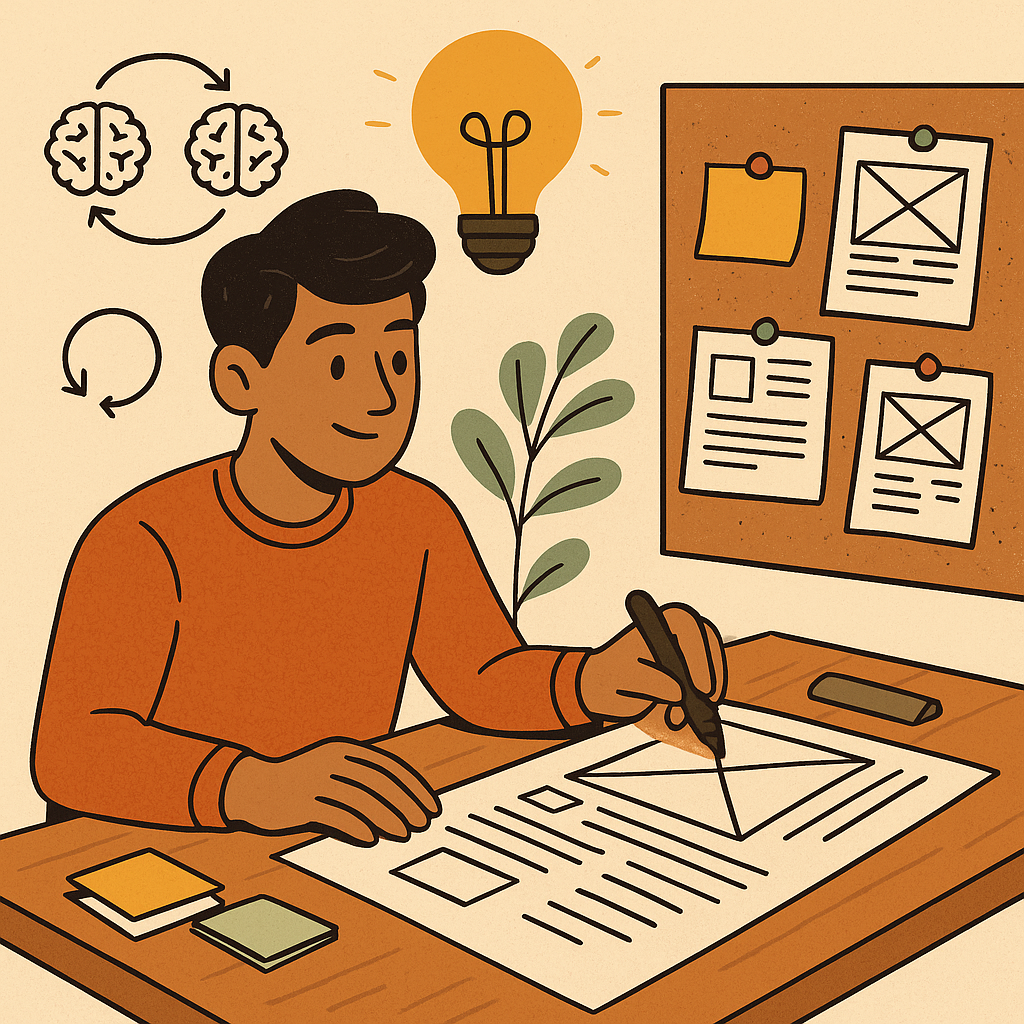Design thinking is no longer just for designers—it’s becoming essential in personal development. By applying its human-centered, iterative, and creative mindset, you can tackle daily challenges, build better habits, and make decisions that resonate with who you are. Let’s explore how design thinking in personal life helps you empathize, prototype, and evolve solutions in today’s fast-paced world.

What Is Design Thinking and Why It Matters Personally
At its core, design thinking is a human-centered approach to problem-solving that follows five steps: empathize, define, ideate, prototype, and test. Traditionally used for products, organizations have adopted it to foster innovation and collaboration . But these principles apply just as well to our own lives:
- Empathize: Understand your own feelings and frustrations.
- Define: Frame what you want to achieve—better sleep, less stress, or a joyful morning routine.
- Ideate: Brainstorm creative ways to improve what you want.
- Prototype & Test: Try small changes, evaluate what works, iterate further.
This structured creativity empowers you to build a life that adapts to your evolving needs.
Emerging Trend: “Life Design” and Personal Life as a Project
“Life design” is an emerging trend that treats your life like a design challenge—available time, habits, and aspirations are your raw materials. Authors Dave Evans and Bill Burnett call it “a new way of life that will transform how you look at your life and how you live” omaritani.com. It’s not just about careers—it’s about building a meaningful life aligned with your values.
Step‑by‑Step: A Design Thinking Guide for Your Everyday
1. Empathize with Yourself
Start by observing your own behaviors and emotions:
- Track mood patterns, energy levels, and obstacles for a week.
- Ask yourself: When do I feel most motivated? When do setbacks occur?
This mirrors empathic design—first understanding latent needs through observation.
2. Define the Right Problem
Reframing is key. Don’t tackle “I’m always tired”—ask why:
- Perhaps it’s poor bedtime habits, digital overload, or unclear priorities.
- Define a specific goal: “Improve my bedtime routine to support energy.”
Reframing ensures you’re solving the right issue .
3. Ideate Broadly
Generate many possible improvements:
- Use “How Might We…” prompts like:
“How might I wind down digitally 30 minutes before bed?” - Invite friends or family to co-create—collaboration boosts creativity.
4. Prototype Quick Wins
Choose one idea and test it briefly:
- Example: Establish a 9 pm no‑screens rule for one week.
- Measure outcome: Did your sleep improve? You may prototype reading or light stretching instead.
Iteration values okay to fail and learn .
5. Test, Learn, Iterate
Assess what worked:
- Maybe no‑screens improved sleep but early exercise energized you more.
- Adapt accordingly—reduce or shift routines until results resonate.
This agile approach helps refine solutions, not just implement them.
3 Hot Trends: Personal Life Meets Design Thinking
A. Mental Wellness & “Lemonading” Mindsets
The “lemonading” trend—actively turning challenges into positive outcomes—is rising. Applying design thinking encourages reframing stressors into design challenges (e.g., “How might I create a calming evening space?”), prototyping soothing rituals, and testing what lifts your mood.
B. Emotional Design at Home
Just as product designers build connection, you can craft emotionally satisfying personal spaces:
- Use soft lighting, textures, and color to support relaxation or productivity.
- Prototype a morning nook, test how it impacts mood, and refine.
Emotional design becomes personal environmental design.
C. Systemic Self-Improvement
Borrowing from systemic design, apply holistic thinking to personal changes:
- Consider life as interconnected systems: health, relationships, habits.
- Prototype changes in one area (like morning walking) and gauge ripple effects—on focus, weight, mood.
- Adapt thoughtfully, understanding the wider system.
Real-Life Examples
Example 1: Designing a Joyful Morning Routine
- Empathize: You dread mornings and reach for distractions.
- Define: You want calm, creativity, energy before email.
- Ideate: Try journaling, 5-minute walks, coffee on the balcony.
- Prototype each for several days and test energy levels.
- Iterate until the best morning flow emerges—maybe day A: journaling; day B: stretching; finalize a combo.
Example 2: Revamping Personal Finances with Design Thinking
- Empathize: You feel anxious reviewing your bank balance.
- Define: You want clarity and control over spending.
- Ideate: Visual trackers, automated transfers, mock challenges.
- Prototype: Use a spending chart for two weeks, measure stress and trends.
- Iterate: Refine categories, automate transfers, and keep improving clarity.
Why This Approach Works
- Human-Centered: Tools like empathic design root your actions in real needs.
- Iterative & Flexible: You’re allowed trials and adjustments.
- Collaborative: Involving friends fosters fresh ideas.
- Emotionally Rich: Integrates emotional design to support well-being.
Practical Tips for Daily Design Thinking
- Keep an Observation Journal – Note emotions, routines, friction points.
- Reframe Challenges – Turn signs of fatigue or boredom into actionable queries.
- Host a Mini Ideation Session – Use “How Might We” questions; invite others.
- Treat Small Wins as Experiments – Start prototypes that run days or weeks.
- Track Outcomes & Adjust – Use simple metrics: sleep hours, mood score, focus.
Conclusion
Design thinking in personal life helps you craft a living experience built on empathy, experimentation, and emotional design. Whether you’re improving habits, mental health, or energy levels, it offers a powerful framework to invent a life that works—and can evolve.
References
Carlye Lauff, PhD — “Applying Design Thinking to Your Life” (Medium, 2017) https://medium.com/@carlyelauff/applying-design-thinking-to-your-life-4ff87047b332
Natalie Stoclet — “Can You Use Design Thinking To Design Your Life?” (Forbes, Sept 2023)
https://www.forbes.com/sites/nataliestoclet/2023/09/05/can-you-use-design-thinking-to-design-your-life/
Bill Burnett (Stanford d.school) — “How to Use Design Thinking to Create a Happier Life for Yourself” (TED Ideas, 2021)
https://ideas.ted.com/how-to-use-design-thinking-to-create-a-happier-life-for-yourself/






